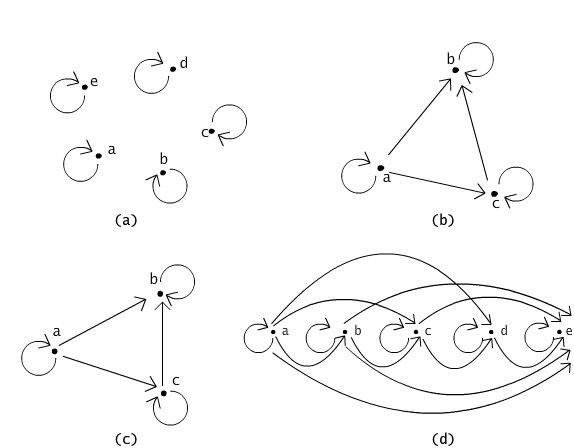| « previous section | next section » |
Definition 5.1.1
Binary relation ≤ in a set X is called the partial order, or shortly, ordering relation if and only if it is reflexive, antisymmetric and transitive, i.e. if for every x, y, z ∈ X,
In the present lecture we shall use the symbol ≤ to denote an ordering relation. The set X in which the ordering relation is defined will be called ordered set and will be denoted by <X, ≤ >. To stress the fact that two elements x and y are in the relation ≤ and that they differ, we shall use the notation x ≤ y. In a similar manner we use the relation ≤ in the set of real numbers R.

Fig. 5.1.1 Examples of partially ordered sets.
In the Figure 5.1.1 we present the examples of graphs illustrating ordered sets. The graph of Figure 5.1.1(a) shows a partial ordering. This relation is obviously reflexive. It does not hold for any pair of different elements and therefore the predecessors of implications (2) and (3) are not satisfied. As a consequence, the relation is antisymmetric and transitive too. The graph of Figure 5.1.1(b) illustrates also an ordering relation. Contrary to the former relation, in this case for certain distinct elements the relation is established: a ≤ b and a ≤ c. The relation illustrated on Figure 5.1.1(c) allows to sequence all elements in a row a ≤ c ≤ b. Similarly as in Figure 5.1.1(d), where any two elements are comparable by the ordering relation.
Question 5.1.1 Is a complete graph an illustration of an ordered set?
----- See answer -----Example 5.1.1
f ≤ g iff for every x ∈ R, f(x) ≤ g(x),
is an ordering relation in the set RR. Indeed, for every x ∈ R holds f(x) ≤ f(x) i.e. the relation ≤ is reflexive. Let f ≤ g and g ≤ f and let x be a fixed real number. By the first assumption, f(x) ≤ g(x) and g(x) ≤ f(x) by the second assumption, hence by antisymmetry of the relation ≤ we obtain f(x)=g(x). This reasoning can be repeated for any x ∈ R, proving in this way that for every x ∈ R, f(x) = g(x). Hence f = g.f r g iff there exist positive constants c and n0, such that f(n) ≤ c*g(n) for n > n0.
According to our definition, two functions f and g are in relation r, if f = O(g), i.e. the function f grows much more slowly than g (c.f. section 3.6). The relation r defined in this way is reflexive and transitive, it is not antisymmetric however. Let f(n) = 2n and g(n) = 5n. Then for every n we have f(n) ≤ g(n) and for every n ∈ N, g(n) ≤ f(n). Hence f = O(g) and g = O(f), but obviously the functions f and g are not equal (f ≠ g).Question 5.1.2 Is the relation < of "being less" an ordering relation in the set R of real numbers?
| « previous section | next section » |